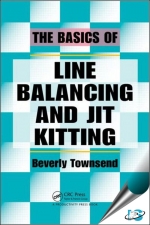Tab Article
Accessible to the Lean novice and shop floor employee, The Basics of Line Balancing and JIT Kitting explores line balancing and the pre-assembly of components into a finished product in a just-in-time fashion (JIT Kitting). It explains how to use time studies, develop yamazumi charts, discover and eliminate waste, balance your line, and create new standard work content for the shop floor.
The book facilitates a clear understanding of the seven deadly wastes (muda) as well as what you can do to eliminate them from your facility. Describing the purpose and use of standard work, it explains how to properly staff work cells and how to develop flex plans for fluctuations in demand using this data. The first few chapters explain how to determine takt time and how to use that information along with time studies to identify when you are not meeting customer demand.
The chapters on JIT Kitting explain how there are other advantages to kitting besides eliminating waste and increasing productivity. The book explains how you can use JIT Kitting to improve quality by having the parts available and limiting the options of numerous parts to the operator. It also provides the understanding needed to ensure the right parts are installed, thereby correcting issues with the build of materials.


